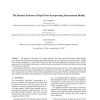Free Online Productivity Tools
i2Speak
i2Symbol
i2OCR
iTex2Img
iWeb2Print
iWeb2Shot
i2Type
iPdf2Split
iPdf2Merge
i2Bopomofo
i2Arabic
i2Style
i2Image
i2PDF
iLatex2Rtf
Sci2ools
IJCV
1998
1998
The Intrinsic Structure of Optic Flow Incorporating Measurement Duality
The purpose of this article is to define optic flow for scalar and density images without using a priori knowledge other than its defining conservation principle, and to incorporate measurement duality, notably the scale-space paradigm. It is argued that the design of optic flow based applications may benefit from a manifest separation between factual image structure on the one hand, and goal-specific details and hypotheses about image flow formation on the other. The approach is based on a physical symmetry principle known as gauge invariance. Data-independent models can be incorporated by means of admissible gauge conditions, each of which may single out a distinct solution, but all of which must be compatible with the evidence supported by the image data. The theory is illustrated by examples and verified by simulations, and performance is compared to several techniques reported in the literature.
| Added | 22 Dec 2010 |
| Updated | 22 Dec 2010 |
| Type | Journal |
| Year | 1998 |
| Where | IJCV |
| Authors | Luc Florack, Wiro J. Niessen, Mads Nielsen |
Comments (0)

